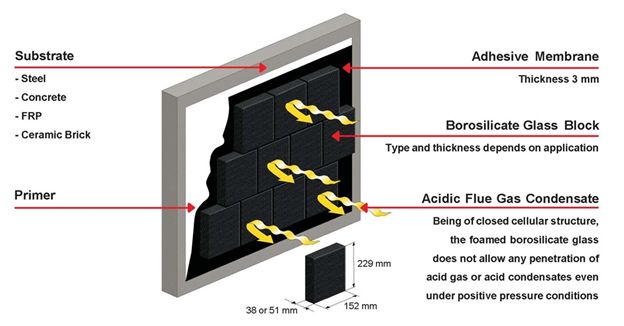Air Quality Benefits of a Borosilicate Glass Block Lining System (BGBLS) for Industrial Stacks
Overview
Borosilicate Glass Block Lining Systems ( "BGBLS ") are commonly used by owners of large industrial chimneys for protection against acid dewpoint corrosion. An additional benefit of BGBLS is their strong insulating property. Consequently, thanks to the presence of a thermally insulating system on the inside of a chimney structure, the gaseous emissions from the chimney will be warmer in the start-up phase, resulting in higher plume rise, lower ground level pollutant concentrations, and possible health benefits for populations in regions surrounding the chimney assuming all other factors are equal.
EnviroComp's Role
EnviroComp, under contract from Hadek1, a global supplier of internal lining systems for industrial stacks, was asked to identify and quantify possible air quality benefits of BGBLS due to the effect of this insulating property on gas emission temperature. Our technical approach was based on the use of computer modeling. We used Computational Fluid Dynamics2 (CFD) software to simulate the motion of gasses inside a chimney during start-up, with and without BGBLS lining. Afterwards, when the gasses are emitted from the top of the chimney, we used another set of models (Air Quality Dispersion Models3) to simulate the concentration impact at ground level of the pollutants emitted from the chimney. These computer simulations allowed us to identify and quantify the changes in plume dynamics and concentration impacts caused by the BGBLS lining and the benefits related to these changes.
We focused on the analysis of start-up events, characterized by the emission of colder plumes, which generally produce higher ground level concentrations.
Two examples of CFD simulation of gasses inside the chimneys are presented here, for a 150 m brick chimney, and here, for a 50 m steel chimney.
Our results in Figure 1 show that without BGBLS lining, a substantial fraction of the plume - the fraction emitted from a circular ring near the internal wall of the stack - is much colder than the plume emitted from the center. For example, if we focus on the 19% fractional emission near the wall, the maximum ground-level concentration impact decreases by 20%, as shown in Figure 2.
For additional information, we enclose the slides of a recent conference presentation describing our work.
1. https://www.hadek.com
2. https://www.simscale.com/docs/simwiki/cfd-computational-fluid-dynamics/what-is-cfd-computational-fluid-dynamics/
3. E.g.: https://www.epa.gov/scram/air-quality-dispersion-modeling


